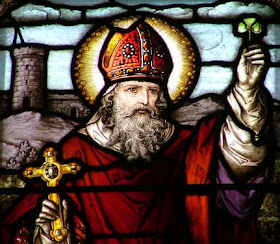Saint Patrick
Saint Patrick's Day (Irish: Lá Fhéile Pádraig, "the Day of the Festival of Patrick") is a cultural and religious holiday celebrated on 17 March. It commemorates Saint Patrick (c. AD 387–461), the most commonly recognized of the patron saints of Ireland, and the arrival of Christianity in Ireland. It is observed by the Catholic Church, the Anglican Communion (especially the Church of Ireland), the Eastern Orthodox Church and Lutheran Church. Saint Patrick's Day was made an official feast day in the early seventeenth century, and has gradually become a celebration of Irish culture in general.
Holiday
The day is generally characterized by the attendance of church services, wearing of green attire and the lifting of Lenten restrictions on eating, and drinking alcohol, which is often proscribed during the rest of the season.
Saint Patrick's Day is a public holiday in the Republic of Ireland, Northern Ireland, Newfoundland and Labrador and in Montserrat. It is also widely celebrated by the Irish diaspora, especially in places such as Great Britain, Canada, the United States, Argentina, Australia, and New Zealand, among others. Today, St. Patrick's Day is probably the most widely celebrated saint's day in the world.
The Man
Saint Patrick was born in Roman Britain in the fourth century, into a wealthy Romano-British family. His father and grandfather were deacons in the Christian church. At the age of sixteen, he was kidnapped by Irish raiders and taken captive to Ireland as a slave. It is believed he was held somewhere on the west coast of Ireland, possibly Mayo, but the exact location is unknown. According to his Confession, he was told by God in a dream to flee from captivity to the coast, where he would board a ship and return to Britain. Upon returning, he quickly joined the Church in Auxerre in Gaul and studied to be a priest.
In 432, he again said that he was called back to Ireland, though as a bishop, to Christianise the Irish from their native polytheism. Irish folklore tells that one of his teaching methods included using the shamrock to explain the Christian doctrine of the Trinity to the Irish people. After nearly thirty years of evangelism, he died on 17 March 461, and according to tradition, was buried at Downpatrick. Although there were other more successful missions to Ireland from Rome, Patrick endured as the principal champion of Irish Christianity and is held in esteem in the Irish church.
Why Green & Shamrocks
Originally, the color associated with Saint Patrick was blue. Over the years the color green and its association with Saint Patrick's day grew. Green ribbons and shamrocks were worn in celebration of St Patrick's Day as early as the 17th century. Saint Patrick is said to have used the shamrock, a three-leaved plant, to explain the Holy Trinity to the pagan Irish, and the wearing and display of shamrocks and shamrock-inspired designs have become a ubiquitous feature of the day. In the 1798 rebellion, to make a political statement, Irish soldiers wore full green uniforms on 17 March in hopes of catching public attention. The phrase "the wearing of the green", meaning to wear a shamrock on one's clothing, derives from a song of the same name.


No comments:
Post a Comment